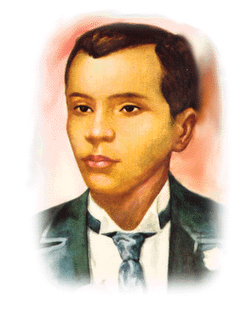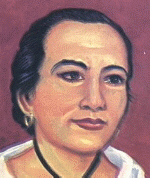
Andres Bonifacio
(1863-1897)
Andres Bonifacio was born in Born in Tondo, Manila, on November 30, 1863.
Bonifacio founded the Katipunan on July 7, 1892 , a revolutionary secret society which would later spark the Philippine Revolution of 1896 against Spanish rule.
In this period, he met his second wife, Gregoria de Jesus,
who became a rebel leader in her own right. His right-hand man was Emilio Jacinto. Within the society, Bonifacio's codename or nom de guerre was Maypagasa (There is hope).
With the establishment of the Katipunan, Andrés
Bonifacio became popularly known as the Father of the Revolution. In the organization, he eventually held the title of Supremo.
Just before the Revolution broke out, he formed a revolutionary government
where he was also president of the Tagalog republic from August 24, 1896
to May 10, 1897.
He wrote the patriotic poem, Pag-ibig sa Tinubuang Lupa which saw print
in the first and only issue of the Katipunan periodical, Kalayaan (Freedom),
edited by Jacinto. Allegedly, he also made the first translation of Jose
Rizal's final poem, Mi Ultimo Adios (My Last Farewell) into Tagalog.
While Bonifacio's personal campaigns were less than successful, the
revolutionaries in Cavite had greater success, led by officers coming
from the upper classes, including the celebrated Emilio Aguinaldo.
Thus, they sent out a manifesto calling for a revolutionary government
of their own, disregarding Bonifacio's leadership.
A council comprising of Bonifacio's men and the Magdalo and the Magdiwang,
two locally-based rival Katipunan factions, held a convention in Tejeros,
Cavite to establish a unified front and settle the issue of leadership
of the revolutionary movement. The Magdalo faction was led by Baldomero
Aguinaldo, cousin to Emilio Aguinaldo. In the elections, the Cavitenos
voted their own Emilio Aguinaldo President. Bonifacio, due to the lack
of a power base in the province, was voted Director of the Interior.
However, a member of the Magdalo faction, Daniel Tirona, questioned
Bonifacio's qualifications for high office, declaring him uneducated
and unfit for the position. Bonifacio was slighted, all the more so
since he had previously asked that the results of the election be
respected by all. Invoking his authority as Supremo, he threatened
those in attendence with a pistol and declared the results of the
Tejeros Convention as null and void and left in a rage. Later, he
wrote to Jacinto about his misgivings about the whole matter, as
he suspected Tirona of spreading black propaganda against him and
fixing the ballots .
Regrouping his forces, he attempted to return to the province of Morong
(now Rizal), where he had a strong base and support. Tried by a moot
court 'in absentia' by the Aguinaldo faction, he was condemned as a
traitor to the Revolution and given the death penalty. An arresting
party of Magdalo soldiers caught up with Bonifacio in the town of Indang
and a skirmish ensued, in which Bonifacio was wounded and his brother
Ciriaco killed. He and his other brother, Procopio, were captured and were subsequently executed by firing squad on May 10, 1897 He was killed on
May 10, 1897, near Mount Buntis, Maragondon, Cavite.
Co-patriots of the Revolution regarded this an ugly blot laid at
Aguinaldo's door, though in fairness Aguinaldo originally wanted
them banished instead.
After many years, Bonifacio's remains were exhumed, but were believed
destroyed during World War II.
The loves of Jose Rizal,
Josephine Bracken,
Nelly Boustead,
Leonor Rivera,
Gertrude Beckett,
Segundina Katigbak,
Oseikiyosan,
Suzanne Jacoby,
Leonor ValenzuelaTagalog Songs,
Tagalog OPM,
Tagalog Songs lyrics,
folk songs,
lyrics,
Filipino singers,
BICOLANO FOLK SONGS,,
Tagalog Folk Songs,
Visayan folk songs ,
Capampangan folk songs,
Ilocano folk songs,
Filipino singers,
Filipino folk dance,
Tagalog+Christmas+Songs,
Pinoy+OPM+Christmas+Songs,
Philippine Heroes,
Andres Bonifacio
























